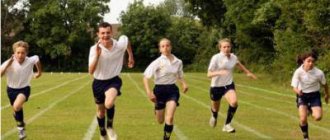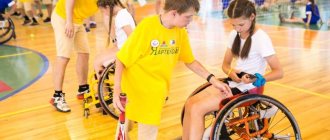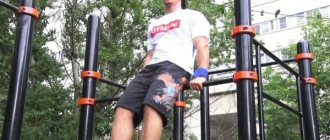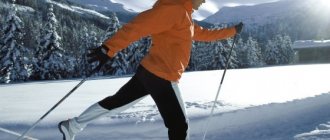Mechanisms of adaptation to physical activity
At the end of this stage, the necessary hypertrophy of organs is observed, the coherence of the activities of various links and mechanisms that ensure the effective operation of the functional system in new conditions.
- The third stage is distinguished by stable long-term adaptation, expressed in the presence of the necessary reserve to ensure a new level of system functioning, stability of functional structures, and a close relationship between regulatory and executive mechanisms.
- The fourth stage occurs with irrationally constructed, usually overly intense training, poor nutrition and recovery and is characterized by wear and tear of individual components of the functional system.
Research by L.Kh. Garkavy et al. general anti-stress nonspecific adaptive reactions of the body were found - reactions of calm activation, increased activation and training.
Adaptation is one of the most essential physiological foundations of athletes’ training activities. The entire training process is aimed at developing adaptation to specific muscle activity. In this regard, A.S. Solodkov considers the process of adaptation to physical activity more specifically and identifies stages that are basically consistent with those indicated above, but slightly different in name.
In the dynamics of adaptive changes in athletes, A.S. Solodkov identifies four stages:
When the body gets used to training. How the body gets used to physical activity
Regular exercise is the best way to maintain a stable weight and stay in great shape. However, even if you work out several times a week and constantly increase the load, you may encounter a so-called plateau - a period when the weight stops falling and the workouts seem to become ineffective. According to the trainers of the Fitness League club, it is during this period that many visitors, not seeing results, refuse to exercise altogether. In order to avoid this, it is necessary to understand how our body reacts to physical activity and what processes occur in the body.
A 10 kg weight loss diet combined with moderate exercise will help you lose most of your weight. The most difficult thing to get rid of is the last three kilograms, many believe. There is some truth in this, because the level of training and endurance of the body is constantly increasing, and you have to work more. If you don't understand the developmental phases your body goes through, you won't be able to achieve your fitness goals and a thigh-loss diet won't help you.
So, experts distinguish two main stages of the training process:
- Activation. During the first weeks, the weight will come off at a breakneck speed. Be prepared for the fact that your appetite will also increase: you can eat for two, this will not affect weight loss in any way. The fact is that during this period the body requires more energy to replenish reserves, and food will act as a “building material” for muscle tissue. You don't need a diet: most of the weight will go away if you eat a balanced diet and exercise regularly. But this is just the beginning - it will be more difficult further.
- Adaptation. After about three weeks, your weight loss process will slow down. Your body will get used to the stress and learn to work using the minimum possible number of calories. During this period, it is important to change your training regimen: if you do not review your program, you will be marking time in one place to no avail. The weight may even increase and the kilograms lost with such difficulty will begin to return. Cold water for weight loss and moving to a new level of exercise can help.
The body needs to be constantly maintained in good shape. Keep in mind that the body adapts to any exercise in just a few weeks, so it is important to change your training program periodically. If you have done fitness exercises with a ball, then join the gym. Instead of a morning jog, go for a bike ride. Vary the duration, frequency, and intensity of your workouts. Having first signed up for yoga classes for beginners, move on to a more complex level. Remember, changes in the training program are a prerequisite for stable results and the key to your progress.
Adaptation of skeletal muscles to physical activity[edit | edit code]
Adaptation of muscles to load according to Seluyanov
As a result of physical activity or inactivity, two types of changes can occur in skeletal muscle fibers:
- changes in their ability to produce ATP as a result of an increase or decrease in the number of enzymes in various energy production pathways.
- changes in the diameter of muscle fibers as a result of the formation or loss of myofibrils (muscle hypertrophy).
Physical activity does not change the ratio of different types of fibers in muscles. Regular physical activity causes the connective tissue of the muscles, as well as their tendons, to adapt.
Central mechanisms of muscle adaptation
Adaptations to endurance exercise edit | edit code
Adaptation of muscles to physical activity
Relatively low-intensity, but long-term physical activity, such as long-distance running and swimming, increases the number of mitochondria and their enzymes in the slow and fast muscle fibers that are involved in this type of activity; The activity of antioxidant enzymes also increases. All these changes lead to increased endurance. The fiber diameter may decrease slightly and thus there is a slight decrease in muscle strength as a result of endurance exercise.
Graph of the study “Neural adaptation to resistance training” (Med Sci Sports Exerc. 1988)
Endurance also depends on the amount of glycogen stored in the muscles before exercise. At high levels of exercise, more ATP per mole of oxygen is produced from glycogen (approximately 6.5 moles of ATP per mole of oxygen consumed) than fatty acid combustion (approximately 5.6 moles of ATP per mole of oxygen consumed). A person on a high-carbohydrate diet can store much more glycogen in their muscles than a person on a mixed or high-fat diet. After fasting, you can expect a decrease in stamina.
In addition, the number of capillaries around the fibers increases. As will be discussed below, endurance exercise also leads to other changes in the circulatory and respiratory systems that improve the delivery of oxygen and energy molecules to the muscles.
When training, eccentric efforts cause more fatigue than concentric efforts. In eccentric work where the muscle resists lengthening, as when walking down a hill, the muscle can suffer microtrauma and muscle pain can be expected.
Read more:
endurance development
Why you don't need to change your training program often. Scientific point of view.
Many people say that the training program needs to be changed frequently to surprise the muscles. This is wrong; it is physiologically impossible to shock the muscles due to their passivity.
In addition, few people know, but each exercise has its own learning curve, a system of neuromuscular adaptation. Those. The body adapts to each exercise in its own way, at different times. This “training period” can take from several weeks to several months, depending on the complexity of the exercise and the qualifications of the athlete. To make it clearer what we are talking about, compare two exercises according to the degree of their mastery - biceps curls and deadlifts. The first one is learned quickly, the second one takes much longer.
So, according to the theory of neuromuscular adaptation, muscle growth at the initial stage (when the body gets acquainted with a new exercise) is minimal. A serious increase in muscle size occurs only after overcoming the “neural plateau” (neural changes plateau).
I present to your attention the graph of the study “Neural adaptation to resistance training” (Med Sci Sports Exerc. 1988), (see Fig. 2). It clearly shows that at first (8-20 weeks) neural (neuromuscular) changes occur in the body and after this period more noticeable muscle growth is observed.
Researchers report:
“Increases in peak strength and the rate of its increase are associated with an increase in the ability of the nervous system to activate an increasing number of muscle fibers during exercise. Strength training can induce adaptive changes in the nervous system that allow exercisers to more fully activate the primary driving forces in certain movements and better coordinate the recruitment of all relevant muscles, thereby providing greater net force in a given direction of movement. The increase in strength occurs mainly due to improved neural adaptation skills, rather than due to muscle growth.”
Conclusion: If you change exercises every 4-6 weeks, then the body will not have time to build a good brain-muscle connection that is involved in a particular exercise. During this time, the body will only be able to adjust this connection, and the athlete will already jump to another exercise (training program). To improve neuromuscular communication, your training program should always include multi-joint exercises for each muscle group. In this case, the neuromuscular connection develops faster than if the training program included only single-joint movements.
Another very important point that requires additional explanation is...
Adaptation of the cardiovascular system to physical activity
Previous12345678910111213141516Next
Under the influence of systematic sports training, due to changes in the vago-sympathetic balance under resting conditions, the diastolic tone of the myocardium decreases. As a consequence of this, more complete relaxation of the myocardium is observed and the diastolic capacity of the ventricles increases. According to indirect calculations, the increase in the latter does not exceed 5-10%.
Thus, relaxation is the initial structural and functional way of restructuring the “sports heart”.
Subsequently, under the influence of systematically repeated loads, accompanied by high demands on the cardiovascular system, elongation of myocardial fibers joins relaxation. This process is based on anatomical changes in cellular elements associated with the activation of protein synthesis.
Structural dilatation (enlargement) of the heart occurs. Both ways of changing the structure of the heart lead to the development of so-called physiological dilatation.
Studies by a number of authors have proven that the process of “relaxation - lengthening” of fibers during the formation of a “sports heart” ends with thickening of the myocardial fibers. This phenomenon is also based on the process of activation of protein synthesis, caused by the intensification of the functioning of structures. This is how physiological hypertrophy of the myocardium develops.
Thus, both processes lead to an increase in heart size: physiological dilatation and myocardial hypertrophy.
Muscle adaptation during strength training[edit | edit code]
“Methodological planning of a training program”
Scientific manual ed. Professor L.P. Lysova, 2016
Changes in muscles during training are extremely diverse and are caused by mechanical irritation, metabolic reactions, as well as hormonal influences (Friedmann, 2007). In this case, two main areas are distinguished, one of which is associated with morphological changes, and the other with neural ones. At the beginning of training, the ability to develop skeletal muscle strength improves quite quickly. This initial increase in performance is largely explained by neural adaptation (Bird et al., 2005; Deschenes and Kraemer, 2002), i.e. increasing the degree of muscle innervation and improving intramuscular coordination. At present, the mechanisms of neural adaptation are not fully understood (Folland and Williams, 2007), however, intermuscular coordination appears to play a large role in this. At the same time, antagonists do not have a significant negative effect on the sequence of movement elements and the consistency of muscle work during movement improves.
When discussing aspects of improving the activation of the nervous system, special attention is paid to specific types of adaptation (Folland, Williams, 2007). This includes possible changes in muscle regulation that occur with simultaneous innervation (synchronization) of a larger number of muscle fibers (recruitment) with a corresponding frequency (frequency of stimulation) (Giillich, Schmidtbleicher, 1999)
Currently, specific types of adaptation at the level of the cerebral cortex are being intensively discussed, i.e., changes in the primary motor cortex of the brain, during brain reflexes and during coactivation of antagonist muscles (Folland and Williams, 2007).
When targeted training is carried out over several weeks or months, morphological changes are also observed in the muscles.
Morphological changes include muscle hypertrophy (Friedmann, 2007). The increase in thickness (hypertrophy) of muscle fibers is due to an increase in the number of contractile and non-contractile muscle proteins. An increase in cross-sectional area represents the primary morphological form of adaptation to strength training over a long period of time (Folland and Williams, 2007). Strength training has a positive effect on protein synthesis, which begins within 3 hours after the end of training and can last up to 48 hours. Hypertrophied muscle is also characterized by an increase in the pennation angle, which affects the contractility of the muscle. Another type of morphological adaptation is a change in the ratio of muscle fiber types. This characteristic can be significantly influenced during training and has great potential for adaptation. The ratio of muscle fiber types sometimes changes significantly. Fibers responsible for rapid force can, with appropriate training, acquire an increased ability to resist fatigue. The proportion of type IIa muscle fibers increases, and the proportion of type IIb fibers decreases (Deschenes and Kraemer, 2002). The opposite option, in which slow, less fatigable muscle fibers are converted into fast ones, seems almost impossible.
Another form of morphological adaptation during training is an increase in the elasticity of tendons and muscle connective tissue (Giillich, Schmidtbleicher, 1999). As a result, force transmission improves and the growth of strength indicators increases at the beginning of contraction, as well as during the development of reactive force. Other processes of morphological adaptation include an improvement in the capillary supply of muscles (Deschenes and Kraemer, 2002) and an increase in the proportion of myofibrils (Folland and Williams, 2007).
Whether hyperplasia is a form of morphological adaptation remains a controversial issue. Hyperplasia refers to the branching and division of muscle fibers and, as a result, their hypertrophy (Folland, Williams, 2007). There are opposing opinions on this matter, and at present the effect of hyperplasia on the physiological diameter of the muscle seems to scientists to be so insignificant that it can be neglected.
Muscle adaptation to strength training
Two types of adaptations occur in response to strength training—neural system adaptation and muscular system adaptation.
Nervous system adaptation
There are three ways the nervous system adapts to strength training: motor learning, motor unit synchronization, and disinhibition.
- Motor learning. The first NS adaptation, motor learning, should be familiar after reading Chapter 4. When initially working on a new exercise (say, multi-grip pull-ups or campus training), your biggest limitation will be the lack of coordination and sensation required to perform the exercise. You should make rapid progress in the first few weeks as a result of motor learning and improved coordination of the main muscles involved, stabilizers and antagonists. After this, further increases in strength will be determined by other adaptive processes.
- Motor unit synchronization is the second type of NS adaptation that increases strength. Let's say you've already developed the necessary coordination and motor skills to perform a certain exercise - or you've added a new exercise that doesn't require training (like hanging on holds). Initial training involves motor units in a random, asynchronous order. Subsequent training increases the synchronization of the motor units, so that gradually the motor units begin to work in unison, which ultimately produces strength and power.
- Disinhibition is the final type of NS adaptation and is most important for upper-intermediate climbers who want to achieve maximum strength and power. The neuromuscular system has built-in feedback mechanisms that aim to ensure safety when greater force is applied. The Golgi ligament apparatus, which is found in muscles, is sensitive to the degree of tension, and in situations where large levels of force are applied, it sends inhibitory signals that prevent further activation of motor units. For many, this defense mechanism limits the use of force below genetic potential. It's like a speed limiter in a car at 200 km/h when it can go 300 km/h. Fortunately, regular high-intensity training reduces the sensitivity of the Golgi apparatus and thus opens up a new level of maximum strength.
The difference between the maximum force applied and the absolute force capacity is called the force deficit. Research has shown that significant strength gains are possible through inhibition-inhibiting training. One study (Tidow 1990) showed that in untrained individuals, strength deficits can be up to 45%, so neural inhibition reduces absolute strength to almost half of potential. The study also shows that targeted training in elite athletes reduces strength deficits to as little as 5%. Thus, significant strength gains are possible even without building large, heavy muscles!
As a final note, the best type of training to inhibit inhibition depends on the extent of the strength deficit. Intermediate climbers, who are likely to have greater strength deficits, will benefit most from heavy weight training (weighted push-ups, weighted hangs, and Horts hypergravity training, etc.). Elite climbers with slight strength deficits can only continue to progress through a combination of high-intensity (hypergravity) and high-velocity (reactive/plyometric) training.
Adaptation of the muscular system
Long-term gains in muscle strength come from increasing the size of individual muscle fibers (see Figure 5.2). This process of muscle building is known as hypertrophy. Since there is a close relationship between muscle size and strength, your ability to get stronger in the long term depends to some extent on hypertrophy.
Graph of the study “Neural adaptation to resistance training” (Med Sci Sports Exerc. 1988)
Of course, large muscles in the wrong places (legs, chest, or shoulders) are unnecessary stress for climbers. Even superdevelopment of all the important flexor muscles may not be so good if it was achieved through non-specific exercises (such as heavy free weight exercises or circuit training). For example, basketball-sized biceps that result from heavy lifting will not only be unusable on rock, but will also hinder effective climbing.
However, any hypertrophy of the muscles of the forearms, arms and back that results from specific training will be beneficial. In fact, experienced climbers who have trained for many years and have little hypertrophy are probably unlikely to train effectively and eat properly. Since hypertrophy most often occurs in response to high-intensity, heavy-load training, you'll want to train in a regimen that enhances this adaptation.
It is interesting to note that a well-trained neuromuscular system is not necessary to be a strong climber. As mentioned in the first chapter, a small number of individuals have ligament attachments that are further from the joints and create greater leverage than most people with normal genetics. These few can experience the gift of being strong. Other genetic factors, such as a lean physique or a high percentage of muscle fibers, may further enhance their physical endowment. With this in mind, you can understand why these rare climbers are incredibly strong no matter how they train, if they train at all. Therefore, it would be a mistake to copy their training methods.
Energy systems
In rock climbing, energy production in the critical flexor muscles typically comes from the ATP-CrP system and the lactate system. The lactate system can operate both in the presence of oxygen (aerobically) and without it (anaerobically).
ATP-KrF system
The ATP-KrP system provides fast energy for high-speed, intense movements such as those found on hard boulders or crux routes. In training, the ATP-CrP system is the primary source of fuel for fast, intense exercises lasting less than 15 seconds, such as walking around campus or doing one-arm pull-ups. ATP-CrP is a high-energy phosphate present in small quantities in all muscle cells. Intense exercise depletes their reserves in seconds.
Lactate system
Chronic, moderate-to-high-intensity exercise lasting 10 seconds to 3 minutes engages the lactate energy supply system. This is the primary energy system that provides you with fuel when climbing a long boulder or a key section of an endurance route. Carbohydrates, in this case in the form of glucogen, provide nutrition to the lactate system, which can work with or without oxygen.
Anaerobic: High-intensity exercise forces muscles to produce energy in the absence of oxygen (anaerobically) with the accumulation of lactic acid. As a result of the accumulation of lactic acid, fatigue, muscle pain, and eventually muscle failure occur. This limitation in anaerobic energy production helps explain why continuous climbing of difficult areas is limited in duration to a maximum of three minutes (without any rest). Therefore, the strategy of climbing as quickly as possible from one resting place to another will be best on difficult routes.
The anaerobic threshold is defined as the level of working oxygen consumption at which the production of lactic acid in working muscles exceeds the body's ability to eliminate lactate. Once you exceed the anaerobic threshold, lactic acid begins to accumulate and muscle failure will soon follow (see Figure 5.3). Depending on conditions, it is possible to cross the anaerobic threshold at an exercise intensity of 50 to 80% of maximum effort. Shortness of breath (oxygen debt) and burning in the muscles are two signs that you have crossed the anaerobic threshold.
Understanding this highlights the importance of interval training in high-intensity climbing. When climbing a difficult route, you will want to avoid crossing the anaerobic threshold for as long as possible. Once you have done this, climb as quickly as possible to a place where you can rest. Only there can you calm down, drop below the anaerobic threshold and allow the body to reduce the concentration of lactate in the blood. Depending on the amount of lactic acid in your body, it will take 12 minutes or more to return to baseline lactic acid levels (Watts 1996).
Aerobic: Muscular activities that last longer than 3 minutes require the use of oxygen to produce energy. Once ATP-CrP reserves have been depleted and lactate levels in the muscles and blood are high (from anaerobic energy production), exercise can only be continued at a reduced intensity (see Figure 5.4). Anaerobic energy production is limited by the liver's ability to remove lactic acid from the blood and convert it back to glucose. Thus, aerobic energy production lasts longer and provides the majority of muscle movement, using carbohydrates, fats (if the exercise lasts long enough) and proteins in the presence of oxygen. Since aerobic energy production does not produce lactic acid, low-intensity movements can last for several hours without stopping (hiking mountains or climbing easy terrain).
Training principles
Understanding basic training principles will allow you to spend the most time on your training. Without diving too deeply into the science of sports, I will try to explain the important principles of specificity, individualization, gradual increase in load, variability, rest and detraining.
Specificity
The principle of training specificity is perhaps the most important of all. It states that the more specific the training is for a particular sport (in speed of movements, body positions, list of movements, type of muscle contractions), the more useful they will be for improving results in this sport. Thus, exercises that are effective for developing climbing strength (grip strength, block retention, dynamic jumping strength) should be very similar to climbing itself. The more specific the training or exercise, the greater the benefits for climbing. Let's look at some examples of how this is put into practice in climbing.
CrossFit or ironclad does not train muscles in the same way that rock climbing does. Therefore, going to the gym is likely to be a waste of time for climbers unless they are in very poor shape. Some recreational climbers may argue with me as they have noticed improvements on the rocks when they practice training with additional weight. Since developing technique and strategy account for most of the progress during the first few years of climbing, these guys will see improvements no matter what kind of training they do. They can likely experience the same progress with additional training such as ice skating or playing poker.
Rubber wrist expanders (or other similar devices) are another example of counterproductive improvements in finger strength. Grip strength is one of the best examples of specificity, as it is highly dependent on the type of grip (closed, open, semi-open), the position of the wrists and elbows, the intensity of the tension, and even the type of tension (isometric, concentric). Moreover, grip strength almost disappears when you are hanging with a near-maximum load, and this is how it should be trained. Following this, the resistance band will be almost useless in rock climbing, although it may have some value as a warm-up or rehabilitation aid after injury.
What about regular pull-ups, the most popular exercise among climbers? Obviously, this movement is similar to climbing, but the position, the degree of tension of the body and, especially, the position of the hands and arms do not vary, as on rocks. Moreover, the ability to stop or lock the arms in some new position is more necessary in climbing than the pull-up itself. Thus, to ensure the greatest transfer of pull-ups to climbing, it is necessary to vary the pull-ups during each approach. For example, you can change the distance between the hands, place the hands at different levels (using a loop), add blocks or stops during the pull-up in different hand positions. This approach will be much more adequate than simply pulling yourself up in the same position.
Finally, let's look at the concept of CrossFit, which is also trying to be used as training for rock climbing. Obviously, the idea of improving your climbing performance by practicing other sports blindly contradicts the principle of specificity. In fact, CrossFit training only seems to be beneficial for sports that require aerobic endurance, such as triathlon.
Personalization
No climber on the planet is like you, so the most effective training program for you will be different from every other climber's. It may sound cliché, but many climbers copy the training programs of their buddies or, worse, imitate the training of elite climbers. I think this is a pretty stupid approach to training. The most sensible training program (for you) will take into account your strengths, weaknesses, previous injuries, as well as your goals and the amount of time you have to work on them. Moreover, since you may recover faster or slower from training than others, your optimal amount of rest may dictate different training frequencies. Therefore, it is wise to develop and implement the program that works best for you and ignore the rest.
Gradual increase in loads
Graduation, as a training principle, states that in order to increase physical performance, it is necessary to subject the body to a level of stress greater than usual. You can achieve this overload by increasing the intensity, volume or speed of your workouts, or by decreasing the rest periods between successful sets. Depending on the exercise and what exercise parameters you want to vary, overload will result in adaptation by developing greater strength, power, anaerobic or aerobic endurance. For example, increasing exercise intensity and speed will increase maximal strength and power, while decreasing rest intervals and increasing volume will increase anaerobic muscle endurance.
While it's a good idea to switch up your loading method from time to time, the best way to add load for you will depend on your current climbing performance. If bouldering is your thing, you'll prioritize strength and power training (and add extra challenge by increasing the intensity and speed of the exercises). If you're training for rope climbing, it's best to increase your training volume and shorten your rest intervals to improve your endurance. Finally, multipitch and big wall riders who need even more endurance should increase the load by increasing the total number of exercises.
Variability
One of the main training mistakes of almost all athletes is not constantly changing their training programs. According to this principle, the body gets used to constantly repeated training loads. So, if you go to the climbing gym and do the same exercises every time, your strength and climbing ability will soon plateau, even though it seems like a good workout. Aim to vary your workouts by type of load (most of all), as well as by varying the types and order of climbing and exercises performed.
Adaptation of muscles to physical activity
Periodization is another form of variation that involves changing the overall intensity and volume of exercise across sessions. For example, when training in the gym, you can vary your training volume between “high volume” (climbing a lot of moderate routes), “high intensity” (heavy power bouldering) and “high volume and intensity” (climbing as many hard routes as possible). routes). You can also change up your workouts every few weeks, like the 4-3-2-1 training cycle described in Chapter Seven. Bottom line: Make variability the starting point of your climbing training program and you'll get surprisingly good results!
Rest
The muscular adaptations we discussed earlier occur between, not during, training sessions. Effective rest and a healthy lifestyle (including adequate nutrition and adequate sleep) are the foundation for maximizing strength gains as a result of training stimuli. As a rough estimate, full recovery (supercompensation) requires 24 to 72 hours, depending on the volume and intensity of training (see Fig. 5.5). For example, it may take only one day to recover from a large volume of low-intensity exercise, such as very easy climbing or just walking in the mountains, while it may take 2-3 days to fully recover from a large volume of high-intensity exercise, such as like climbing multiple routes near your limit, or doing campus training and hypergravity training in one session.
Supercompensation phases
The importance of this principle cannot be overstated, as training too often (or resting too little) will naturally lead to poor performance and/or injury (see Figure 5.6). This is known as overtraining syndrome, and it is surprisingly common among strong climbers. Observe how many climbers constantly complain about persistent injuries or that they “aren't getting stronger” despite their dedication to hard training. Now you know why: overtraining.
Principle of training planning
Another factor that leads to overtraining or unusually long recovery periods is the application of too many training stimuli to the neuromuscular system. As illustrated in the supercompensation cycle (Figure 5.5), training stimuli lead to neuromuscular fatigue and a temporary decrease in functional ability. With appropriate rest, the system will recover to a level higher than before. Interestingly, continuing to work up to a certain point leads to improved subsequent adaptation, and further efforts lead to muscle failure, after which a long recovery will be required. This is an important concept to remember when doing high-intensity training. Doing 12 sets on campus will probably provide no more stimulus for adaptation than 6, but doing 12 sets will put you in a deep hole that will take a long time to climb out of. The same arguments can be made against doing 20 sets of pull-ups or 60 minutes of hypergravity training on a fingerboard. Bottom line: With high-intensity training, less is often more.
Detraining
When you stop strength training (or constant climbing), recent gains in strength begin to slowly be lost in just 10-14 days. More significant strength losses will occur in the following weeks if training or climbing does not resume. While it's good to take a short break every year (mentally and for chronic injuries), constant breaks from training make long-term strength gains very difficult.
If you often have to travel for work or other reasons to interrupt your training for 1-2 weeks, you can stop the development of detraining syndrome by knowing that the period of supercompensation after high-intensity training is extended. Since we've already learned that it can take several days to recover from a long, high-intensity workout, doing such a workout before taking a break will delay the onset of detraining by several days. This way, you can return to training in peak shape even after 10 days of absence. The long period of supercompensation after extremely hard training also explains why many climbing enthusiasts who were unknowingly overtraining reach new levels after taking a week off from climbing and training.
Tips for effective physical training
|
Training methods
Below are detailed basic concepts and methods of strength training for rock climbing. Since the flexor muscles are often the primary physical limiting factor in climbing, examples of how to apply this information to climbing will help focus training on these body parts.
Previous27Next
Adaptation of the heart to physical activity. Physiological and pathological hypertrophy of the heart.
Adaptation in a broad sense is the adaptation of an organism to its environment, to the conditions of its existence. The living conditions of an athlete differ significantly from those observed among people who do not engage in sports. This is the need to adhere to a strict daily regimen, stressful conditions during competitions, frequent travel, changing time zones and climatic zones, subordination to the requirements of the coach and, finally, the need to systematically perform heavy physical activity. Let's consider the adaptation of the athlete's body to muscular work, since in its manifestation, a significant contribution is made by biochemical mechanisms. The generally accepted definition of such adaptation is the following. Adaptation to muscular work is a structural and functional restructuring of the body, allowing an athlete to perform physical activity of greater power and duration, to develop higher muscle efforts compared to an untrained person. Biochemical and physiological mechanisms of adaptation to physical activity were formed during the long evolution of the animal world and are recorded in the structure of DNA.
Adaptation to physical activity
For a long time, with hypokinesia in humans, there is no pronounced reaction from myosatellite cells (satellite cells) and connective tissue of the endomysium. Only with a long duration of the process, namely, in the 12th month of the experiment, an increase in the number of collagen fibers and signs of activation of satellite cells appear.
Morphologically, physiological atrophy of skeletal muscle fiber is characterized by the preservation of the normal relationship of structures in it with their quantitative decrease, which ensures subsequent recovery. Physical activity against the background of hypokinesia does not prevent the structural and functional changes caused by it, but delays their development, accelerates readaptation and helps stimulate the recovery process through the use of physical exercise.
It is important to note that in type I fibers the preventive effect of loads ceases earlier, starting from the 2nd month of the experiment, in type II fibers - somewhat later (from the 4th). In addition, the use of physical activity largely erases the picture of the onset of stabilization, although, starting from the 4th month of the experiment, the state of the fiber stabilizes at a higher level than without physical activity
Thus, prolonged hypokinesia leads to adaptive restructuring of skeletal muscle tissue fibers. It is associated with quantitative changes in the contractile and energy apparatus of fibers without changing their phenotype. If the energy system is more dependent on easily changing factors of voluntary contraction and its metabolic consequences (hypoxia, energy deficiency, etc.), then contractile structures are stable and depend on neurotrophic influences, through a feedback mechanism (afferent innervation) that monitors internal state of the fiber.
⇐ Previous232425262728293031
Date added: 2015-07-13; ; Copyright infringement?;
The problem of adaptation to physical activity, or fitness, has long attracted the attention of researchers and currently remains one of the pressing problems of pedagogy, biology and medicine. Its essence lies in revealing the mechanisms by which an untrained organism becomes trained, i.e.
mechanisms that form the basis for the formation of positive effects of adaptation, providing a trained organism with advantages over an untrained one, and negative ones, which are caused by the so-called cost of adaptation. The benefits of a trained body are characterized by three main features:
A trained body can perform muscular work of such duration or intensity that an untrained body cannot do it.
A trained organism is distinguished by a more economical functioning of physiological systems at rest and under moderate physical activity and the ability to achieve such a high level of activity at maximum loads that is unattainable for an untrained organism.
A trained body increases its resistance to damaging influences and adverse factors.
If the first two features are of interest for the physiology and pedagogy of work and sports, then the third feature forms the basis for the use of adaptation to physical activity in medicine as a means of preventing diseases in healthy people and as a means of treating and rehabilitating patients.
The “price” of adaptation to physical activity depends on the functional capabilities of the body and the magnitude of the load. The higher the load and the lower the functionality, the more expensive the “price” is associated with performing such muscular work and, often, the body’s adaptation to it cannot be achieved - stabilization of functions does not occur.
The importance of physical fitness for the adaptation of the human body to various living conditions
“Scientific aspect No. 2-2019” – Humanities
Dotsenko Natalya Anatolyevna is a teacher at the North Caucasus branch of the Russian University of Justice.
Abstract: This article discusses the issues of adaptation of the human body to various living conditions. The body’s dependence on the functioning of systems at rest and under load. Resistance of the human body to the effects of adverse environmental factors. What adaptive functional changes occur in the human body during physical activity, as well as the coordinated activity of the nervous, endocrine and immune systems.
Key words: Health, fitness, body, stability, performance, person, physiology, adaptation, recovery, load.
One of the important problems of physiology is the study of the laws of the process of adaptation of the human body to various environmental conditions. The main factors are the following processes:
- restructuring of regulatory organisms;
- mobilization and use of physiological reserves;
- the formation of a special system for adapting specific labor (sports) human activity.
These three physiological factors are the main components of the process of general biological regularity.
The basis of health and highly productive activity of the human body is adaptation to various living conditions and its effectiveness. The basis for the effective use of physical exercises for rational physical training aimed at preserving and strengthening people’s health and increasing their performance is the study of the patterns of adaptation of the human body to various living conditions.
To the memory of P.A. Kotov “ adaptation is the process of adapting the body to the external environment.” Physical training is based on the principle of adaptation, that is, on the ability of a living organism to adapt to different conditions.
When considering physical training, we are interested in such manifestations of adaptation associated with physical activity, as well as with the reactions of the athlete’s body to its implementation. The problem of adaptation of the human body to various living conditions comes down to the question of the mechanisms that provide some advantages to a trained body over an untrained one, in turn, characterized by the following main features:
The first feature: a trained body is more economical in the functioning of physiological systems at rest and under moderate loads. For example, in people with high physical fitness at rest, the heart rate (HR) can be only 40-50 beats/min, the respiratory rate is reduced to 10-12 (even 6-8) breaths. /min at 16-20 breaths. /min in untrained people; pulmonary ventilation and minute volume of respiration are reduced by 10-12%, oxygen consumption by the body as a whole is reduced by 10-12%, and oxygen consumption by the myocardium is reduced by approximately 20% compared to untrained individuals.
The second feature: a trained person’s resistance to the effects of adverse factors increases, due to the fact that his body can perform physical activity of much greater duration and intensity, which, in turn, will be beyond the strength of an untrained person. For example, a person who is not involved in physical education is not able to run a marathon or lift a barbell with a weight significantly exceeding his own, but when performing standard work that is accessible to an untrained person, a trained person can do it for a longer time without fatigue.
The third feature: under maximum load, the body of a trained person is able to achieve a level of functioning of physiological systems that is impossible for an untrained body. During extremely hard work in a trained body, there is a significantly greater mobilization of the circulatory and respiratory systems and a greater waste of energy compared to an untrained one. So, with maximum work, oxygen consumption in a trained person can increase to 5-6 l/min, and in an untrained person it does not exceed 3 l/min, minute blood volume can increase to 45-47 l, and stroke volume - up to 200 ml, then as for an untrained person, the maximum value of these indicators is, respectively, 20-25 l and 140-145 ml; pulmonary ventilation can reach 150 l/min, and the respiratory rate can reach 60 breaths. /min.
The importance of physical fitness for the adaptation of the human body to various living conditions directly lies in the fact that fitness pursues the goal of healing. Adaptive functional changes occur in the human body during physical activity. A trained person differs from an untrained person (not involved in physical education) in having good posture and greater resistance to risk factors.
Also, the immune system takes a direct part in the body’s adaptation to motor activity. The development of physical fitness ensures the coordinated activity of the nervous, endocrine and immune systems.
Improving a person’s health through physical training is achieved by observing standard norms and regimes of physical labor. One of the reasons for this is the satisfaction of the genetic need of the human body for movement, which can be realized in the form of spontaneous motor activity or physical activity. Physical activity directly contributes to the accumulation of the biological and energetic potentials of the body, increases mental and physical performance by increasing the power and efficiency of the internal organs, optimizing nervous and hormonal regulation, and the coordinated interaction of various functional systems.
The importance of physical fitness for the adaptation of the human body lies in increasing metabolism during physical work, which occurs gradually, depending on its severity, accompanied by an increase in heat generation and heat transfer. The process of heat generation is ahead of the process of heat transfer, which contributes to an increase in body temperature, and as a result, leading to loss of excess weight. This explains the demand for physical activity among people who want to lose weight.
Thus, physical fitness is of great importance for the adaptation of the human body to various living conditions. It is expressed in the improvement of the human body, organizes the coordinated functioning of physiological systems in the human body, increases the metabolic rate, as well as mental and physical performance.
Bibliography
- Physical Culture. Lectures: textbook for university students / Maleichenko E.A., Dotsenko N.A., Krasyuk G.V., Skidan M.N. / Publishing house: M.: UNITY-DANA. 2020.- 159 p.
- Human Physiology/Ed. V.M. Pokrovsky, G.F. Korotko. Educational literature for students of medical universities/ Electronic library of medical literature (electronic resource): https://saxum.ru/447/241.htm. (date of access: 04/20/2019).
Interesting article? Share it with others:











